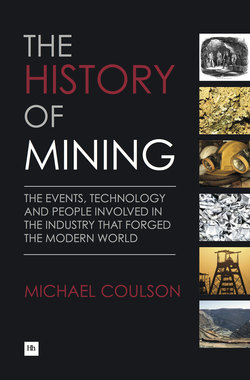Читать книгу The History of Mining - Michael Coulson - Страница 11
На сайте Литреса книга снята с продажи.
3. The Iron Age
ОглавлениеWith the coming of the Iron Age, the final period of pre-history, mining took a step forward, certainly as far as efficiency was concerned. One of the problems with earlier mining was the fact that stone implements were the main tools for digging and breaking rock, and they were not particularly robust and were thus prone to become unusable quickly. Bronze was too valuable and too soft to be a realistic substitute in the making of such heavy-duty tools, but the coming of iron introduced an altogether tougher and more durable metal, ideal for tool making. The Iron Age brought to four the number of important metallic compounds that could be used to make weapons and other durable tools – namely copper, brass, bronze and iron. These proved of material help in the advancement of civilisation, particularly in the hands of the Romans.
The Iron Age itself, like previous ages, emerged in staggered sequence – in the 12th century BC in Greece and the Near and Middle East; a century later in India; and between the 8th and 6th centuries BC in the rest of Europe, with central and southern Europe ahead of the north. But iron was known and used in small quantities many centuries before that, with the earliest use being in the 4th millennium BC by the Egyptians. We have also seen that meteorites rich in iron were the source that ancient Egyptians tapped for the limited iron objects that they fashioned – spear tips for example. Much of this use of iron was ornamental and in no sense was iron widely used to make primary products such as tools and weapons. It was also more expensive than gold in those times because of its rarity, and also was viewed by some as a metal sent from the gods (it came out of the sky after all) and therefore sacred.
Once conventional sources of iron ore were found, which proved far easier to work than the earlier meteorite sources, the possibilities for making iron objects multiplied. The earliest method of turning ore into iron metal was to combine it with carbon and then melt the treated ore in a basic furnace until it became a spongy mass – sponge iron. The iron was then beaten with hammers and folded until all the carbon was released through oxidisation. The resulting product was wrought iron with very little in the way of impurities. Further heating of the wrought iron in charcoal, followed by water-cooling, produced a harder metal due to the process which added a steel surface to the wrought iron. Whilst this process did not completely achieve the hard finished product that was to follow through the making of cast iron, the ability to achieve the sponge iron stage did mean that, with relatively low temperatures in the early furnaces, an iron product could still be made.
The first objects made from mined iron ore came from Anatolia in the 12th century BC and this spread throughout the Middle East, and it was from here that it is thought iron ore mining and iron making spread to China where wrought iron objects made in the 8th century BC have been found in the north west of the country near Xinjiang. Sources of iron ore were reasonably available once the technology for making finished iron had been mastered. In the 5th century BC, during the Zhou Dynasty, kiln technology was developed which enabled the iron ore to be heated to much higher temperatures than formerly, which led to the manufacture of cast iron. The technology had spread to India by the 2nd century BC.
